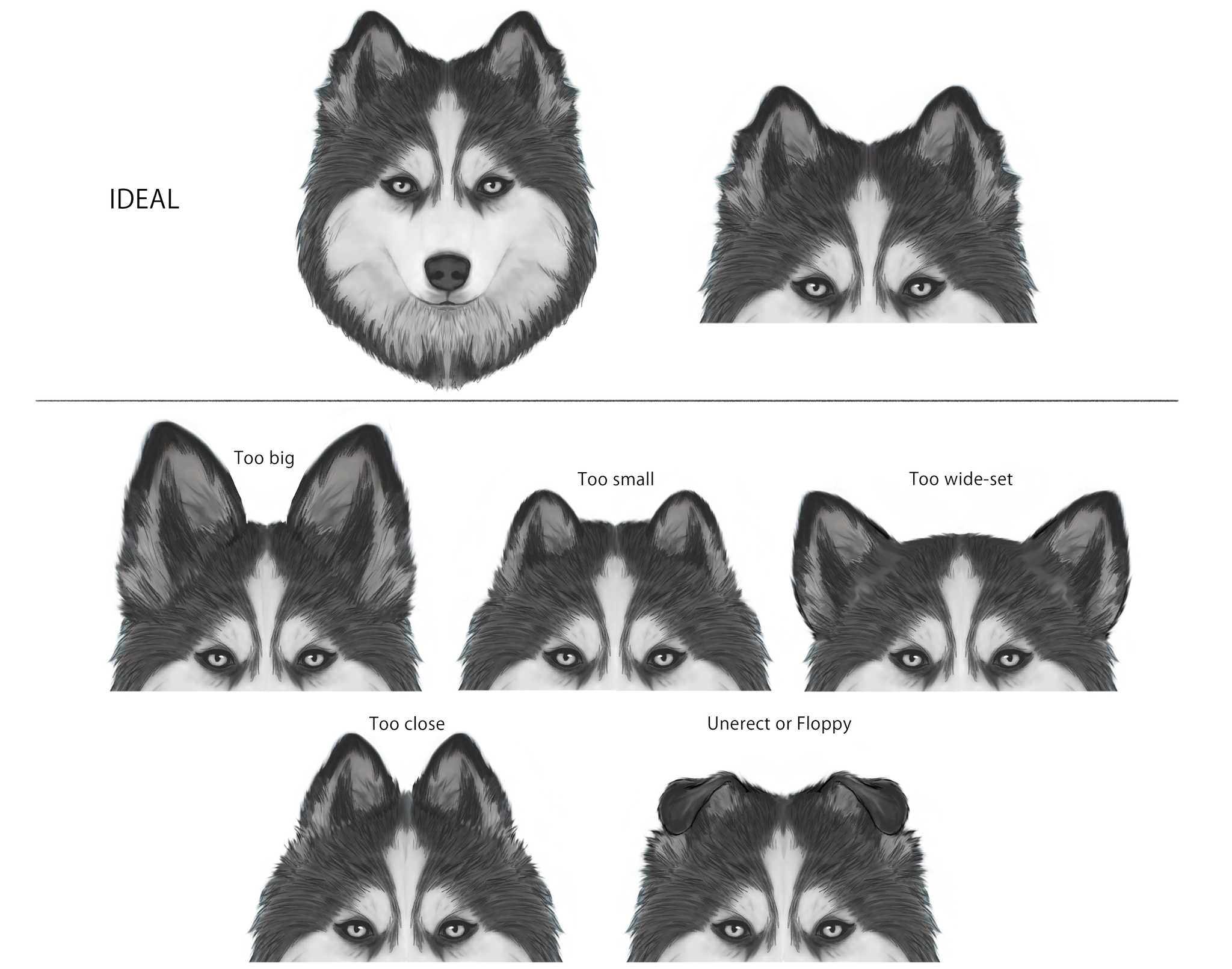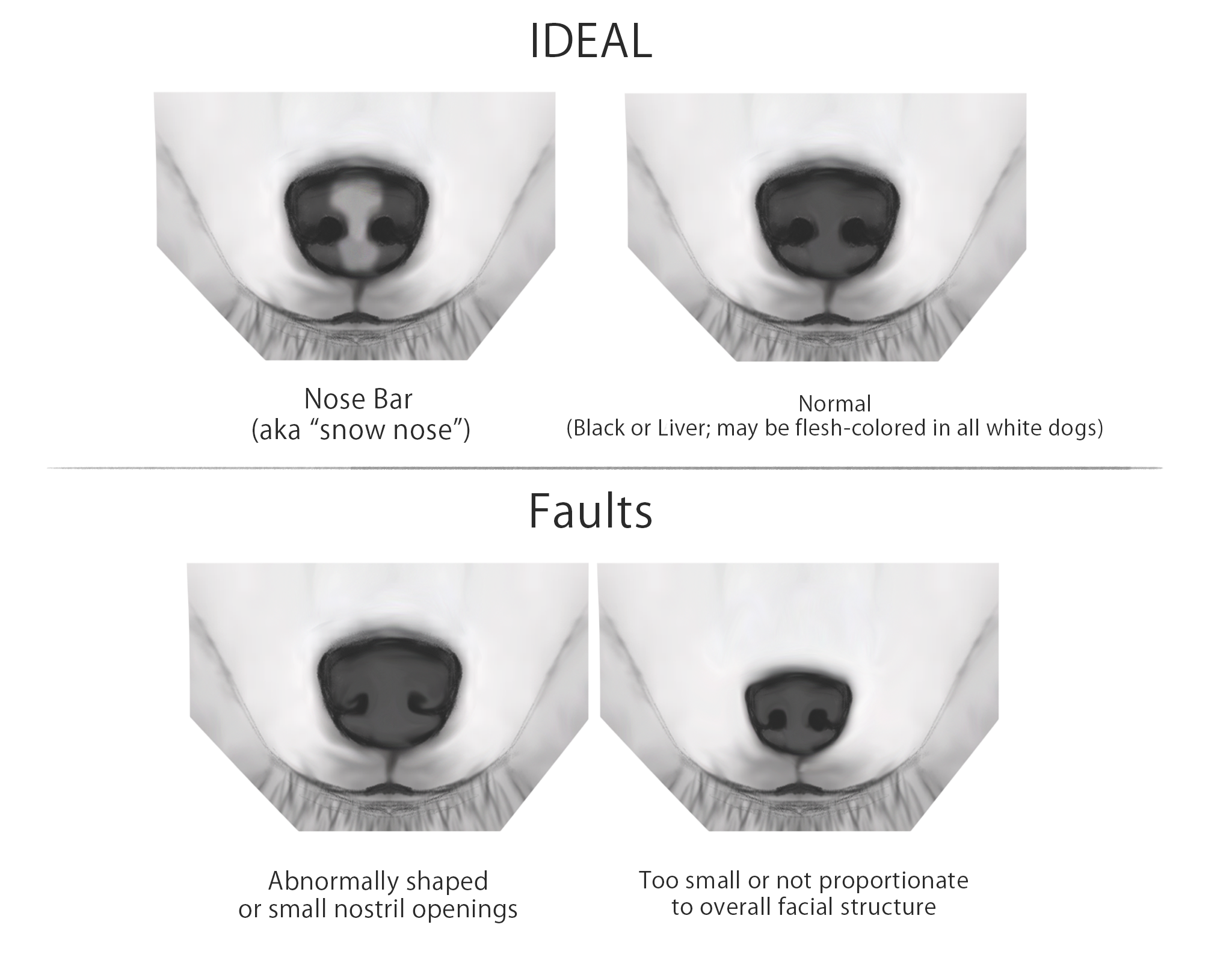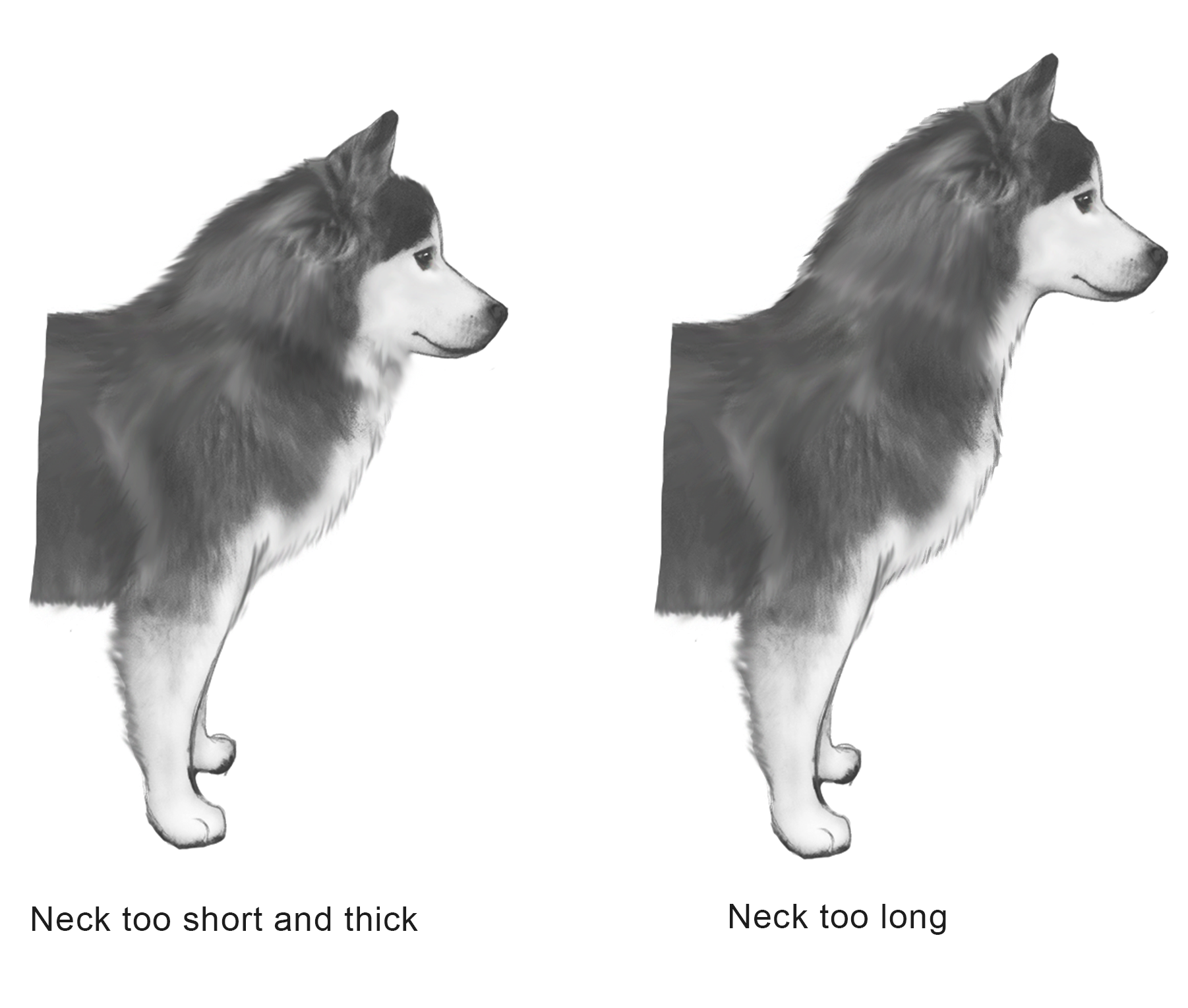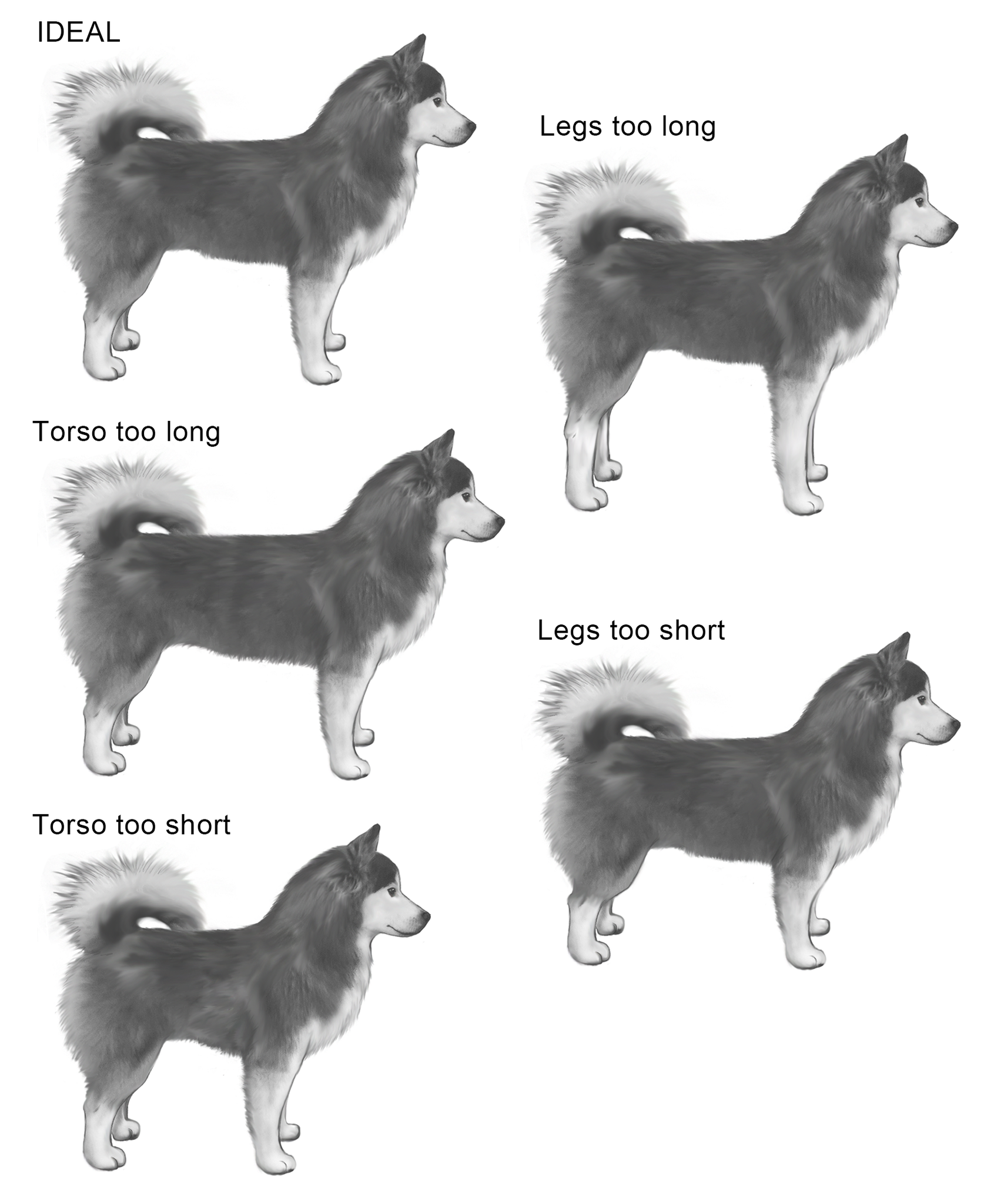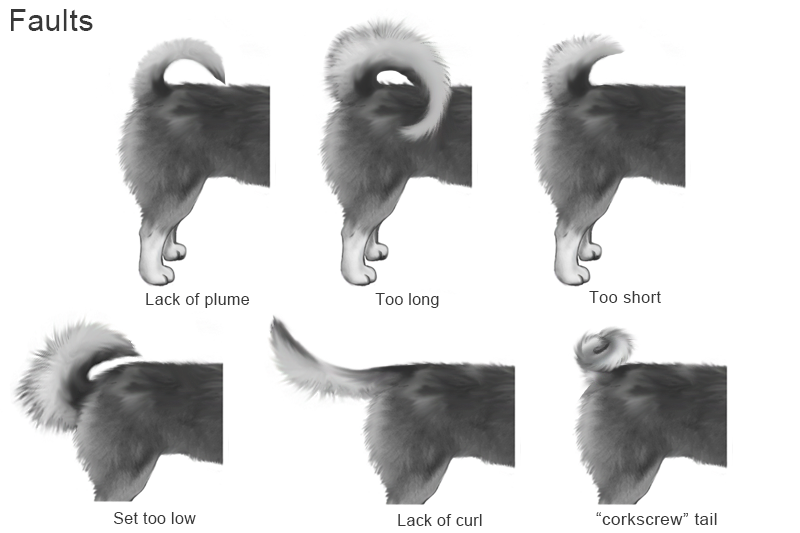This is the illustrated American Pomsky Kennel® Club Breed Standard.
Illustrator is Ariel Carpenter, Pathfinder Pomskies
Link to PDF version.
BREEDS
Pomskies were created using a Siberian Husky female and a Pomeranian male, using methods of artificial insemination due to the size differences between these two Spitz breeds.
With the AKC judge-sanctioned event of PomskyFest in March 2019, the judges were able to physically look over the variety of Pomsky combinations and generations. They determined that the American Eskimo was a good addition as we progress towards AKC recognition. As 50/50 mixes of Husky/Pomeranian, the dilemma presented was that the Siberian Husky is a ‘square’ dog and the Pomeranian is a ‘triangle’ shape dog.
The addition of the American Eskimo not only further contributes to the ‘square’ design that works best with this breed, but there have been improvements to the coat texture, temperament, and shedding season of these mixes. As we progress, additional breeds may be considered as experimental as the kennel club considers what would be best to improve the overall look and body structure of this newly emerging breed.
POMSKY SIZES/WEIGHTS
TOY Under 10” tall at the shoulder, and up to 15 pounds.
MINI Up to 14” at the shoulder, and between 12-20 pounds.
STANDARD 14-18” tall at the shoulder, and between 20-35 pounds.
Dogs that fall between categories should be judged by height rather than weight.
As this is a newly emerging breed, dogs that do not exactly fit the sizing category should not be disqualified. That said, Pomskies should NOT be overweight, they are designed to be athletic dogs.
The goal for Pomskies is not to create a Husky-masked Pomeranian. Rather, it is to create a smaller version of a Husky. Thus, Pomeranian body features, such as deep stop, head shape, and dainty legs are all considered as faults.
HEAD
POMSKY SKULL composition should be in balance with the body, slightly rounded on top and tapering from the widest point to the eyes. Neither too large or too small for the frame of the dog.
FAULTS: Too broad or too narrow, nor have an ‘apple head’ or prominent bulged forehead common in other breeds like the Chihuahua.
When toy Pomskies are produced, the apple head should be avoided.
EYES
POMSKY EYES will be almond-shaped, moderately spaced, and sized.
Eyes may be brown, amber, green, gray, or blue in color; one of each or parti-color are all acceptable.
FAULTS: Too oblique, lack of angle or downward, or set too close or too far apart. Bulging eyes, off-set directions, and excessive tear stains.
EYE COLOR
POMSKY EYES may be brown, amber, green, gray or blue in color; Heterochromatic, one of each or parti-colored are acceptable.
EARS
POMSKY EARS of small to medium size, triangular in shape, close fitting and set high on the head. They are thick, well furred, slightly arched at the back, and strongly erect, with slightly rounded tips pointing straight up.
FAULTS: Ears too large in proportion to the head, too wide or low set on the head, or not strongly erect.
MUZZLE
POMSKY MUZZLE of medium width, tapering gradually to the nose, with the tip neither pointed nor square. Muzzle of medium length equal to about 1/3rd of the head; that is, the distance from the tip of the nose to the stop is equal to the distance from the stop to the occiput.
The stop is well-defined and the bridge of the nose is straight from the stop to the tip.
Lips are well pigmented and close fitting.
FAULTS: Muzzle either too short or too long. Stops too oblique or too angular(deep). Droopy lips. Clipped lips due to over/under bites.
TEETH
POMSKY TEETH closing in a scissor bite.
FAULTS: Under and overbites greater than 1/8” and teeth not closing in a scissor bite pattern.
NOSE
POMSKY NOSE is black in gray, tan, or black dogs; liver in chocolate and sable dogs; may be flesh-colored in pure white dogs. Snow nose/nose bar can be seasonal and is acceptable in Pomskies.
FAULTS: Abnormally shaped or small nostril openings. Too small or too large of a nose or not proportionate to overall facial structure.
NECK
POMSKY Neck is medium in length, arched, and carried proudly erect when dog is standing. When moving at a trot, the neck is extended so that the head is carried slightly forward.
FAULTS: Disproportionate to the overall body structure. Neck that is too short and thick, or too thin and long.
OVERALL
POMSKY OVERALL COMPOSITION Solidly built, with moderate bone. Male reflects masculinity, without coarseness. Bitches, femininity but without slightness of bone. Athletic build preferred.
FAULTS: Torso too long or short for body. Legs too long or short for body.
TOPLINE
POMSKY TOPLINE is straight and strong with a level topline from withers to group. It is of medium length, neither cobby nor slack from excessive length. The loin is taut and lean, narrower than the rib cage, and with a slight tuck-up. The croup slopes away from the spine at an angle, but never so steeply so as to restrict the rearward thrust of the hind legs.
FAULTS: Weak or slack back, roached back, sloping topline. Disproportionate length to the overall body structure.
POMSKY SHOULDERS. The shoulder blade is well laid back. The upper arm angles slightly backward from point of the shoulder to elbow and is never perpendicular to the ground. The muscles and ligaments holding the shoulder to the rib cage are firm and well-developed.
FAULTS - Straight shoulders; loose shoulders.
CHEST/RIBS
POMSKY CHEST deep and strong, but not too broad, with the deepest point being just behind and level with the elbows. The ribs are well sprung from the spine but flattened on the sides to allow for freedom of action.
OVERALL BODY COMPOSITION - Solidly built, with moderate bone. Male reflects masculinity, without coarseness. Bitches, femininity but without slightness of bone.
FAULTS - Chest too broad; "barrel ribs"; ribs too flat or weak.
FORELEGS/PAWS
POMSKY FORELEGS: When standing and viewed from the front, the legs are moderately spaced, parallel and straight, with the elbows close to the body and same length from wither to elbow and elbow to ground, and turned neither in nor out. Viewed from the side, pasterns are slightly slanted, with the pastern joint strong, but flexible. Bone is substantial but never heavy. Dewclaws on forelegs may be removed. Dewclaws on forelegs are recommended to be kept if present.
FAULTS - Weak pasterns; too heavy bone; too narrow or too wide in the front; out at the elbows.
PAWS - Oval in shape but not long. The paws are medium in size, compact and well-furred between the toes and pads. The pads are tough and thickly cushioned. The paws turn neither in nor out when the dog is in a natural stance.
FAULTS - Soft or splayed toes; paw size not in balance with rest of body; toeing in or out.
HINDQUARTERS
POMSKY HINDQUARTERS angulation balances that of the forequarters. Buttocks are well behind the set of the tail.
Thighs - moderately muscled with good pastern development. Upper thigh and lower leg length are equal.
Stifles - strong, moderately bent and clearly defined. Legs - when viewed from the rear straight and parallel to each other.
Hocks when viewed from the side are perpendicular to the ground and strong.
Feet same as forequarters.
Hind Dewclaws are not common in most lines but may be removed without fault.
FAULTS - Cow hocks, knees turning in or out, patella weakness or lack of soundness in legs or stifles. Lacking good pastern development. Leggy, not in balance with rest of body, and following overall breed standard body composition.
GAIT
POMSKY GAIT should be similar in form to their Husky counterparts; light, graceful and with ease. Fore/hind les move and meet together on the same side of the body.
FAULTS - Crabbing, crossing, clunky gaits
TAIL
POMSKY TAIL is profusely covered with long, harsh spreading hair forming a plume. The well furred tail of fox-brush shape is set on just below the level of the topline, and is usually carried over the back in a graceful sickle curve when the dog is at attention. It can be snapped over the back as is typical in Pomeranians or may follow the Husky standard sickle.
FAULTS - Tightly curled “piggy” tail. Not well-furred tail. Hanging or tucked tail. Sitting too high or too low on the body. Lack of plume, lack of curl or too short/long.
MASKS
POMSKY MASK - As the goal of Pomskies is to create a miniature version of the Siberian Husky, Husky masks are highly desirable.
However, markings should not be the most important judgment when choosing your breed stock. Body structure, health, and temperament are first priority.
COATS
POMSKY COAT has four acceptable coat types, all double-coated and giving a well-furred appearance. Guard hairs of the overcoat are straight and somewhat smooth lying, never harsh nor standing straight off the body. It should be noted in the absence of the undercoat during the shedding season is normal.
Standard - short length, dense fur, generally 1” in length
Plush - medium length, dense fur, generally under 3” in length (may also be coined ‘Medium’)
Wooly - long length, dense fur, generally more than 3” in length
Extreme Wooly - This can also be defined as a triple-coat. Thicker and longer coat than a typical wooly.
Pomsky fur often has a kinky texture from the Pomeranian, as well as the addition of the ruff around the neck and the thigh and hind leg skirting, this is not a fault. It has been noted that the addition of the American Eskimo to the breed lines has created a silkier texture to the fur.
For judging events, each coat type should have its own category. If there are not sufficient participants for multiple categories, the dogs should be judged on the structure and not coat type.
COLORS
POMSKY COLORS:
As Pomskies are a mix of both the Siberian Husky, Pomeranian, and American Eskimo breeds, all color combinations that are naturally occurring in the parental breeds are acceptable and are not considered a disqualification.
A secondary committee is being formed to create a library of colors based on their genetic DNA locus panels and will be released at a future date.





